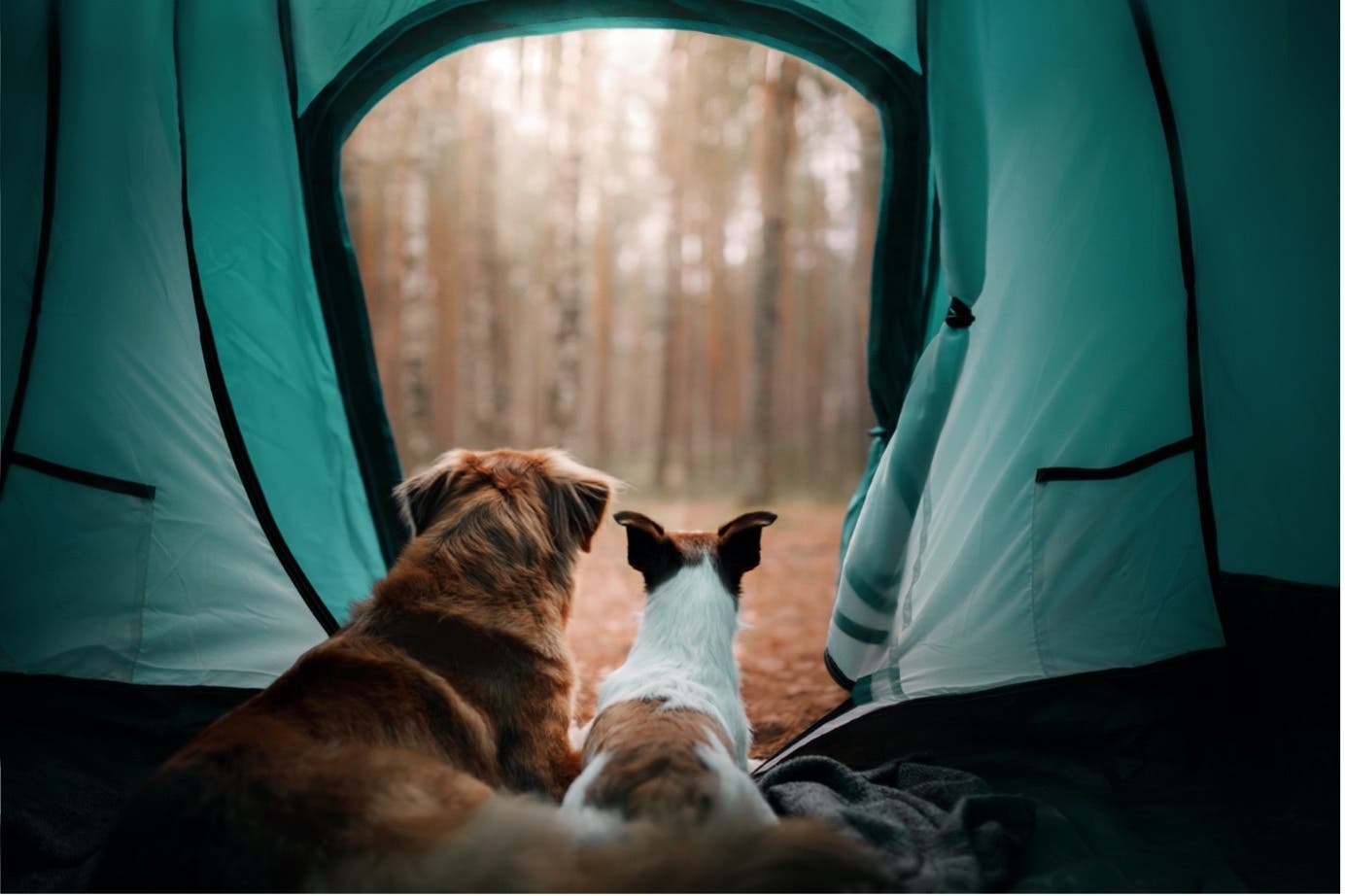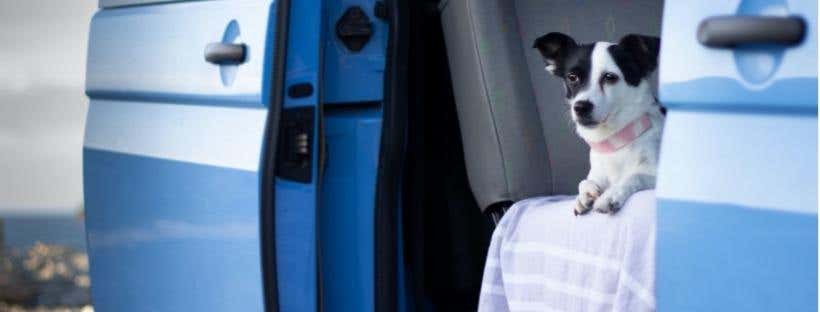In response to COVID-19, many campsites are closed or restricted, and camping activities may seem limited to your own garden. Health and safety continues to be a top priority for camping enthusiasts and their pets, and so it’s advisable to show caution when planning for camping trips ahead by complying with government guidance.
One of the biggest advantages of camping holidays is the freedom to bring along your beloved dog. Like any other camping enthusiast, dogs relish the thrill and sense of adventure it brings. Camping can offer pet-owners the freedom to share their adventures with their dogs.
It may be tempting to bring along your dog as a travelling companion but, when it comes to camping with pets, it’s always safer to travel prepared. With a focus on comfort and security, travelling and camping with your dog can be thoroughly enjoyable.

Camping with Your Dog
Campers who travel with their dogs get to combine their passions. Unlike other conventional holidays, like jet-setting abroad, travels in a campervan are easier on pets. It can seem relatively simple to travel with a dog in your campervan, but there are still key considerations for their comfort and safety.
With a few simple tips, you can ensure that your travel companion remains safe, comfortable and is able to enjoy the journey as much as you do.
1. Find a Dog-Friendly Campsite
For newcomers, it’s important to remember that every campsite follows an expected etiquette, especially where facilities may be shared. These rules and regulations are, typically, posted and advised in advance of your stay. Often campsites, especially in peak times, will have a pet fee, which is a nominal amount per night or a small upfront payment.
As travellers with dogs will be responsible for their companions, they should thoroughly read the rules of guidance, which is likely to change between campsites. Some sites may even be pet-free, so it is worth checking before you travel. Giving advance notice to the site where you intend to bring along your dog is also best practice, as the site authority may ask you to pitch near other dog owners.
Conventional campsite guidance for dog owners includes:
- Dogs must often be leaded and not allowed to roam on the site loosely, or unescorted by their owners.
- Dogs must be exercised in designated pet areas or off-site.
- Owners must clean up after pets and ensure the site remains tidy, clean and hygienic for other guests.
- Owners must limit pets behaving like a nuisance to other guests, including anything that causes a disturbance like repeated or loud barking.
- Under the Dangerous Dogs Act (1991), certain breeds of dogs may be prohibited.
The specifics of campsite rules will vary between sites, but there will always be etiquette that those travelling with dogs should acknowledge, whether it relates to hygiene or other responsibilities.
Guide Dogs and Campsites
Unlike those travelling with pets for leisure, if you rely on a guide dog for health reasons like mobility, then different rules may apply. Guide dogs are, typically, allowed more freedoms around a campsite because they’re classified as a mobility aid. If you’re travelling with a guide dog, you will be exempt from some of the standard campsite rules for pets, so you can unlock access to more areas around the site and move more freely.
2. Safety Starts in Your Camper
Whilst the temptation is to plan for your dog’s comfort and safety at the campsite, you’ll need to ensure that your campervan is pet-safe for the road. Whilst you can make your camper a safe setting for travels with a dog, you should also be familiar with the lawful guidance on driving with pets.
Whilst it is legal to travel with pets, legal guidance under the Highway Code advises that dogs should be fastened at all times and restricted from the front seats.
According to Rule 57 in the Highway Code, travellers should “make sure dogs or other animals are suitably restrained so they cannot distract you while you are driving or injure you.”
Ultimately, when travelling with a dog in your campervan, consider using a speciality harness to comfortably and safely keep them fastened. They should also be kept under control and away from open windows to prevent harm or injury. The Highway Code suggests a seat belt, harness, pet carrier, or dog restraint for travel.
The Highway Code is advisable and breaking its guidance can invalidate your insurance and increase risk of harm or injury. To ensure your pet’s comfort and safety when using the roads in the UK, comply with these safety guidelines. This will make holidaying with your dog even easier.

3. Camping for Comfort
Whether your newcomer or a veteran, it’s always good to be properly prepared for camping with a dog. And one of the bigger challenges involves sleeping arrangements.
Commonly, campers will wonder about their camping arrangements and if it is truly compatible with their dog’s needs and comfort. Is my tent large enough? Where will my dog sleep in the night? Should they sleep separately? How can I make them comfortable?
Ideally, when you’re camping with a dog you should focus on their comfort. You can get creative with where your dog sleeps, as long they have access to a cosy shelter at night. Consider, for example, using a large tent with a separate porch, giving you both space at night. Or, if you’re tight on space, use a separate portable dog tent, referred to as a pup tent. If you are using a pup tent, check the booking rules, as some may require a supplement on top of your nightly fee.
4. Familiarity Helps
When you’re on the road, it’s tempting to miss home. For your dog, plan to pack and bring along personal items, such as familiar toys and snacks that help them feel settled and comfortable. You should aim to create a familiar setting within your campervan and tent so that your dog can settle at night.
It’s not uncommon for changes in scenery to cause them stress and anxiety. But if you bring along our recommended essentials for camping with dogs, you can help them feel at home, even when you’re travelling.
Try to bring along:
- A collar and lead to keep them reigned in and safe on-site.
- Dog bowls for travel.
- Dogs supplies for toileting.
- Bedding and other sleep supplies.
- Towels for your dog’s hygiene.
- Tents, cages, or a favourite basket.

5. Upgrade Your Gear
Many experienced campers have separate gear for travelling with their dogs. Whether mudding through rougher terrains and weather, to tenting in the outdoors, you’ll need to ensure your gear is durable and hard-wearing.
From leashes and weather-resistant harnesses for greater durability to upgrades in your camper, you can prepare better for holidaying with your dog by improving your gear. For example, is your dog’s leash durable enough? Tough weather and rougher terrains are common on camping trips, so plan for their safety by ensuring they have the right gear when you need it.
It helps to carry spare supplies in case of emergencies, or for weathering rainy spells. The likes of spare, or fresh bedding, towels, and backup bowls can come especially in handy if you get stuck camping through tough weather.
Planning on a camping adventure with your dog in the near future? Explore Just Kampers’ range of camping essentials today to ensure your gear is upgraded and ready for your next camping adventure.



